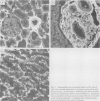Abstract
The occurrence of IgA class reticulin and endomysium antibodies was examined with the standard immunofluorescence method in coeliac disease and dermatitis herpetiformis. Similar high antibody frequencies were detected in 32 untreated adults (91%) and 18 children (100%) with coeliac disease and in 14 dermatitis herpetiformis patients with subtotal villous atrophy (reticulin antibodies 93% and endomysium antibodies 100%). The specificity of IgA class reticulin antibodies and endomysium antibodies was high because all 45 adult patients with ulcerative colitis or Crohn's disease, 24 non-coeliac children with abdominal symptoms and 99/100 healthy blood donors were negative for these antibodies. The only positive blood donor had both IgA class reticulin antibodies and endomysium antibodies but also she was found to have coeliac disease. IgA class reticulin antibodies and endomysium antibodies declined in parallel during treatment with a gluten free diet and increased on gluten challenge. This suggests that these antibodies can be used to screen for gluten sensitive enteropathy and to monitor dietary treatment. To characterise the tissue specificity of reticulin antibodies and endomysium antibodies four positive sera were absorbed with human and several rodent liver homogenates. Absorption with rat or other rodent livers removed the rodent-specific reticulin antibodies but not the reticulin antibodies detectable with human tissues or the endomysium antibodies detectable with monkey oesophagus. These results show that reticulin antibodies can be divided into the rat and human subtypes. The human subtype could not be separated from endomysium antibodies in the present absorption experiments.
Full text
PDF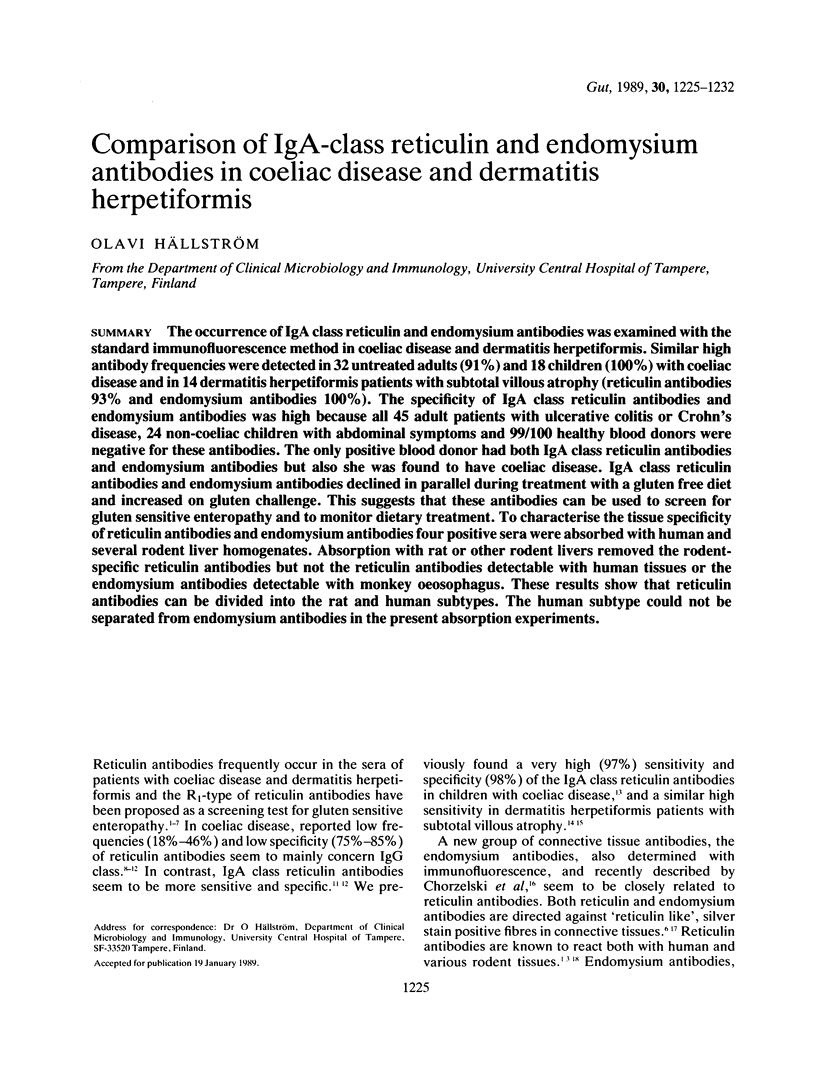
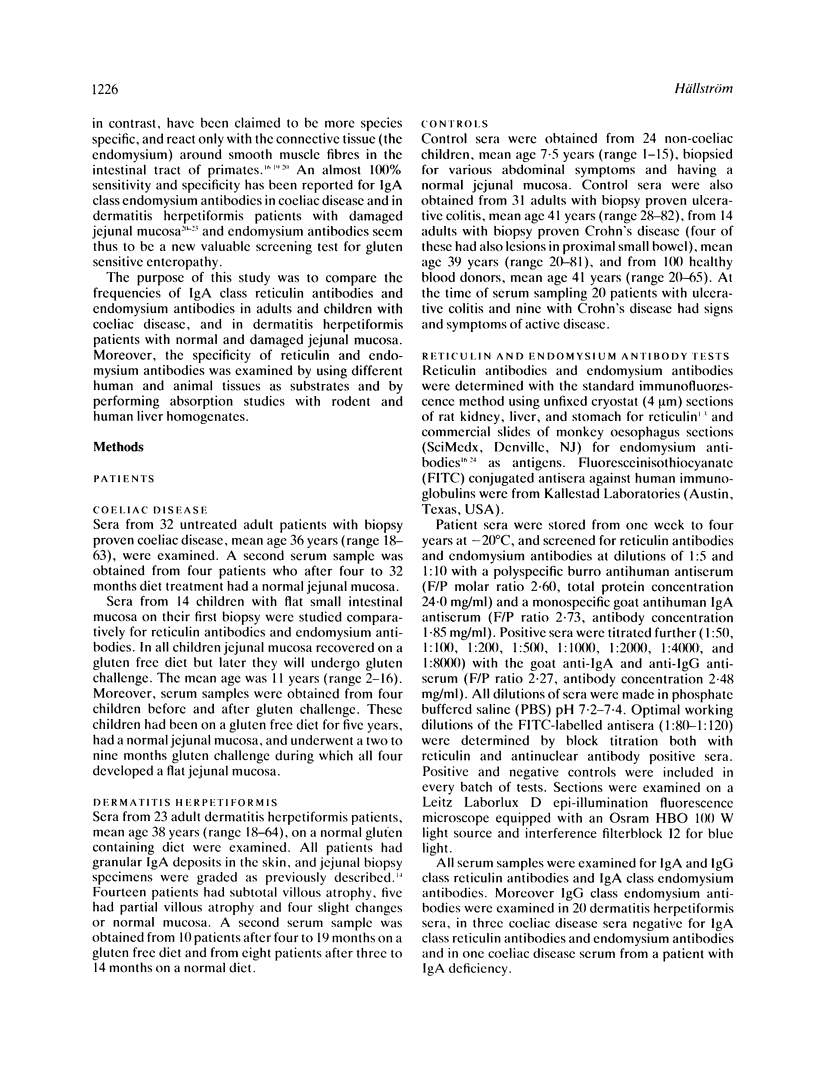
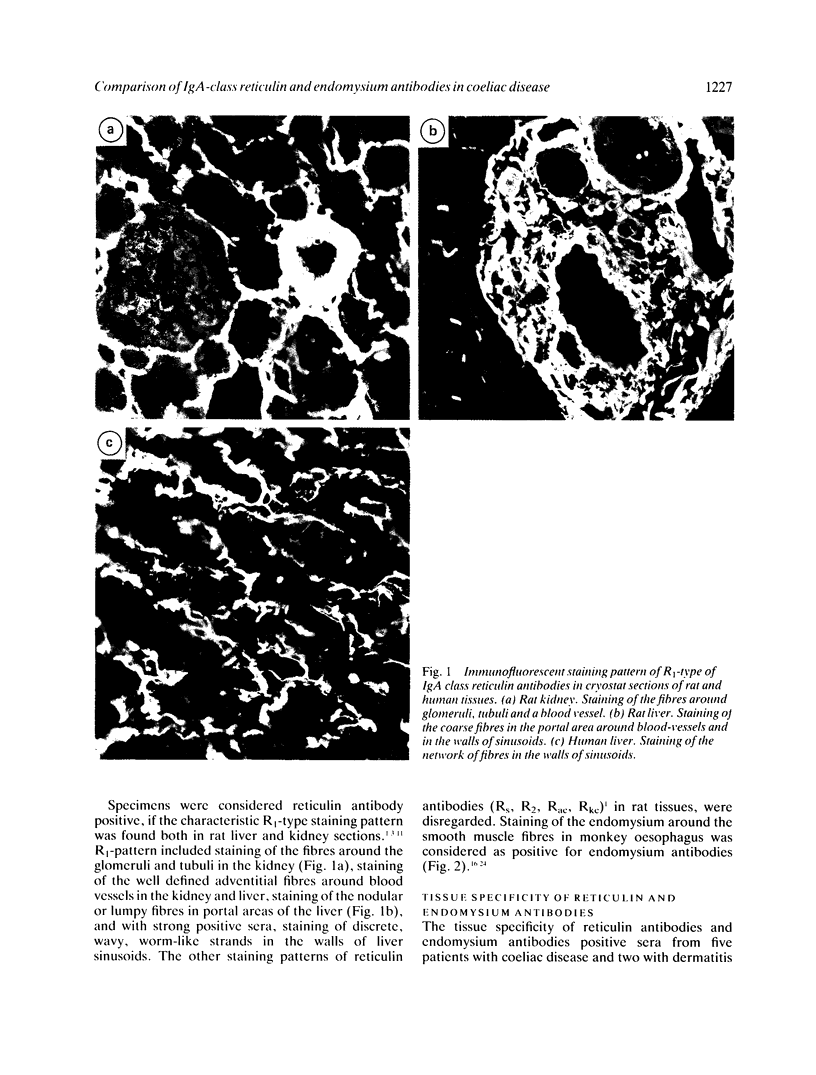
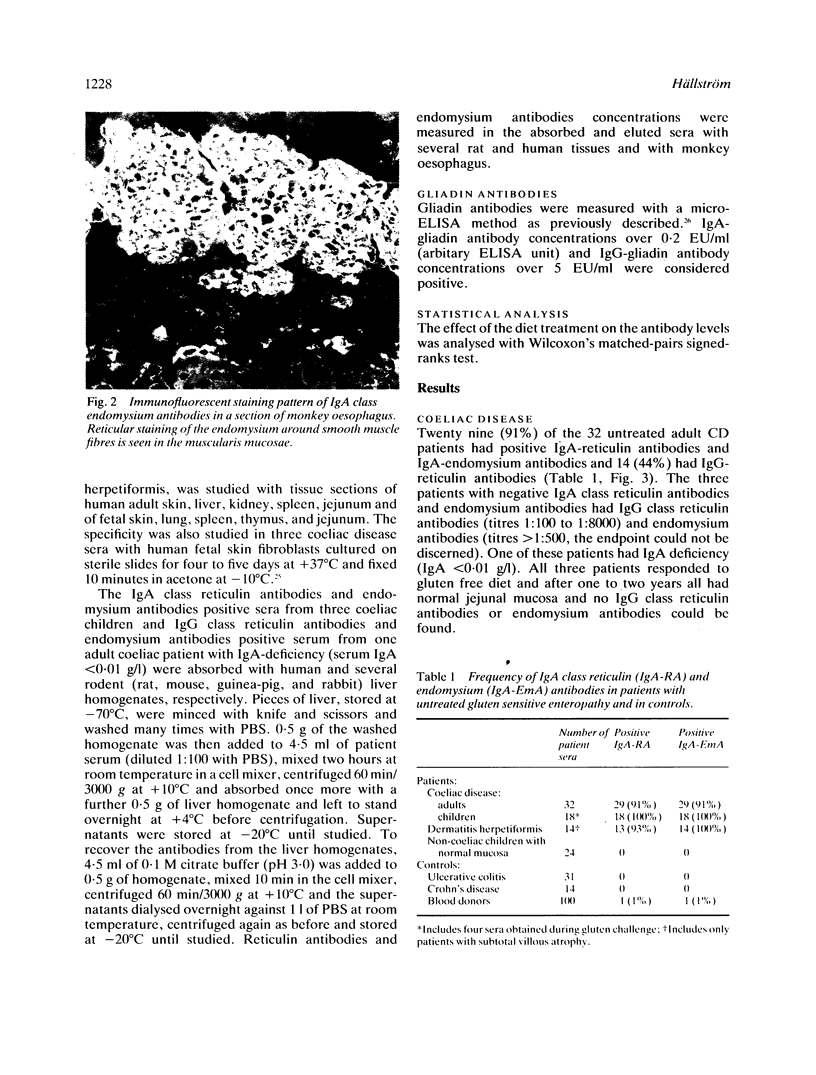
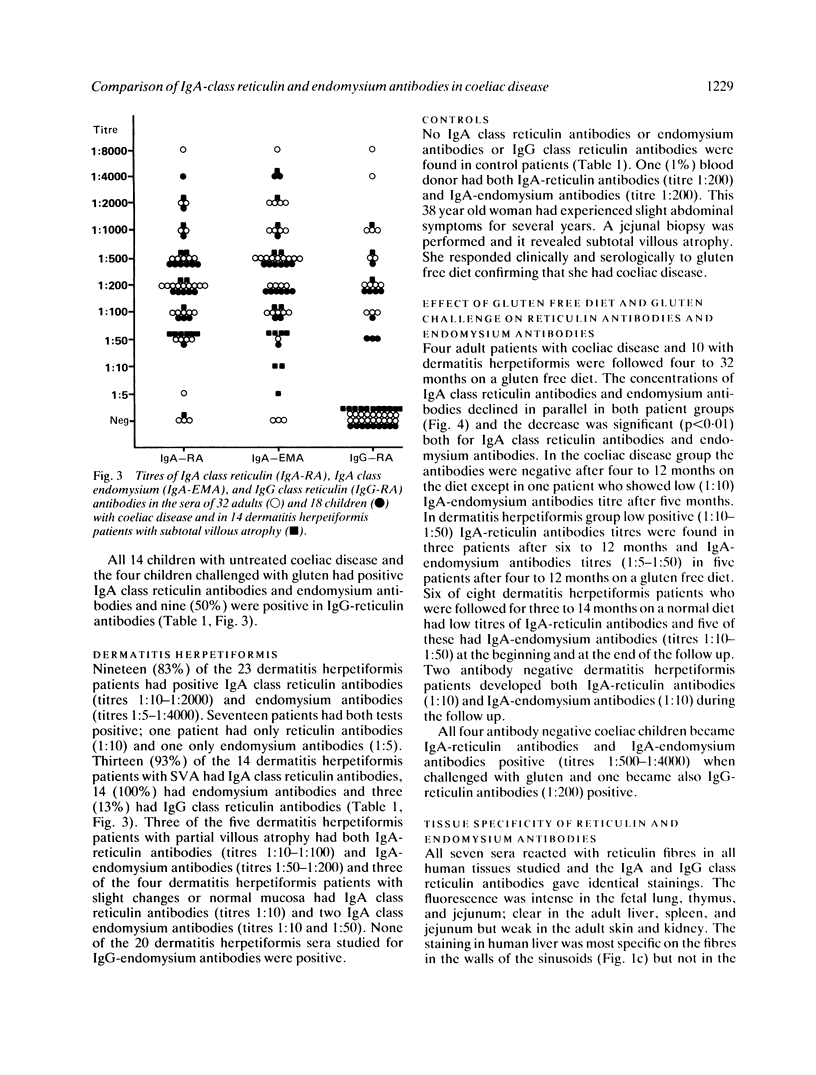
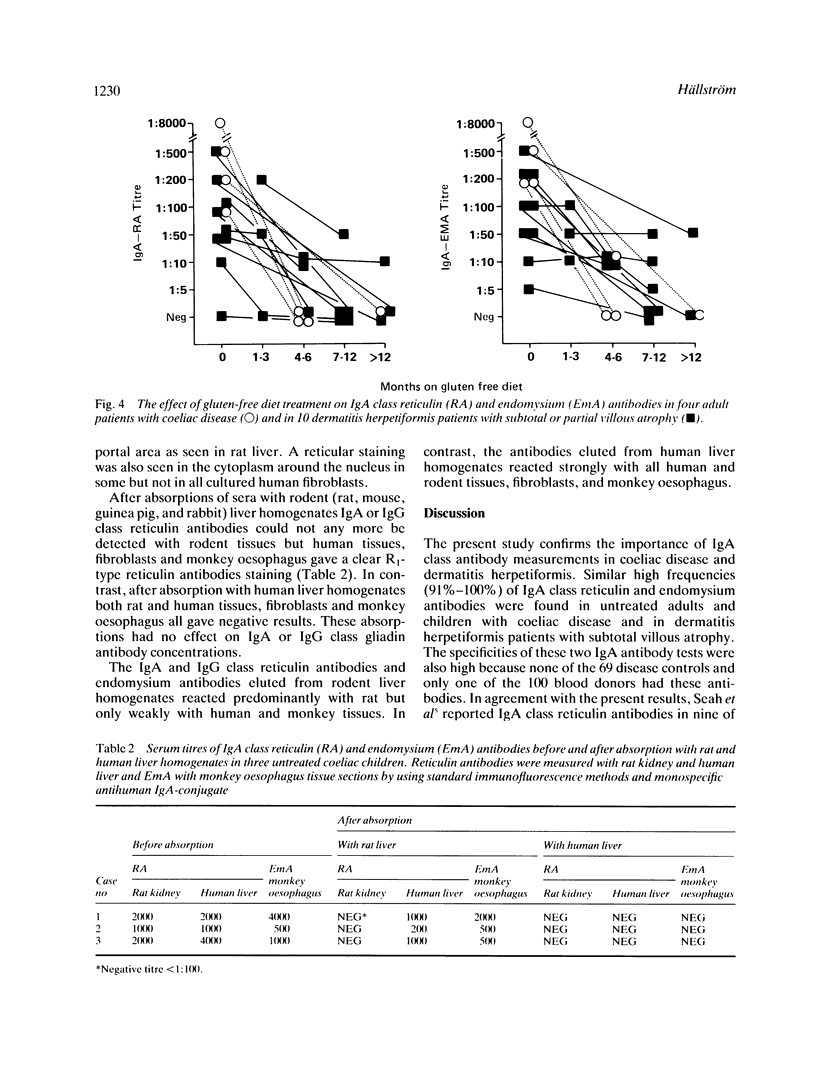
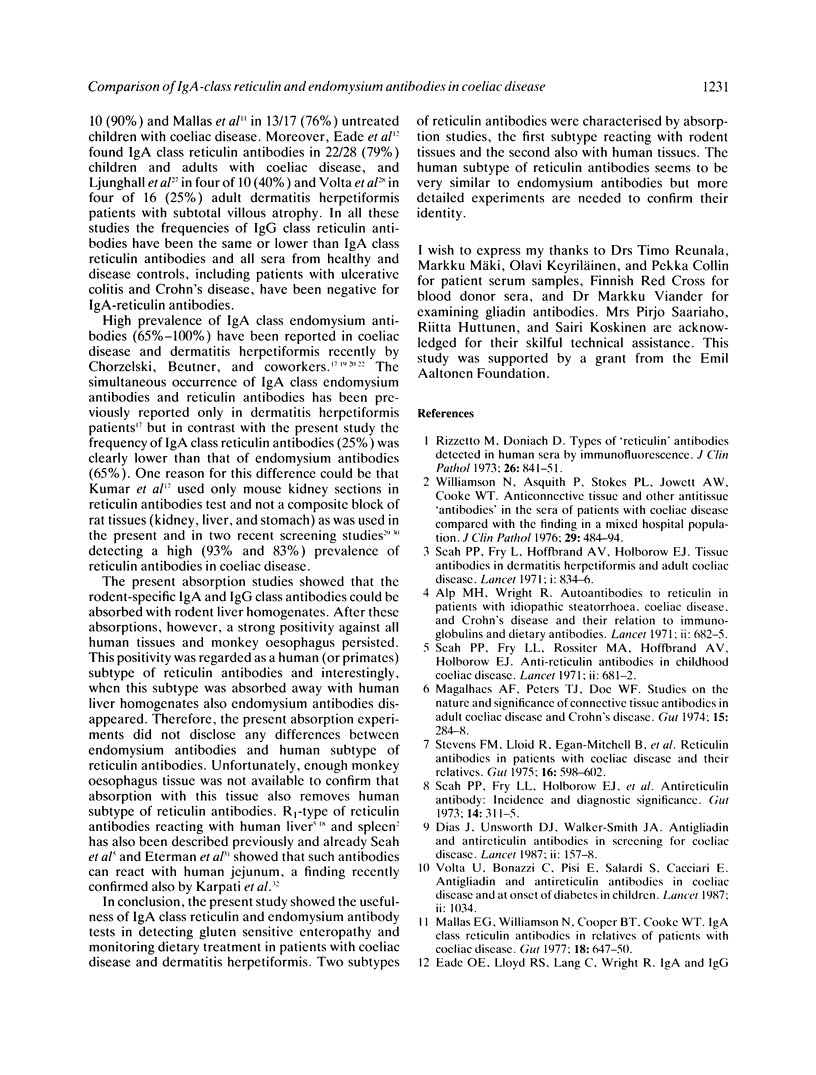
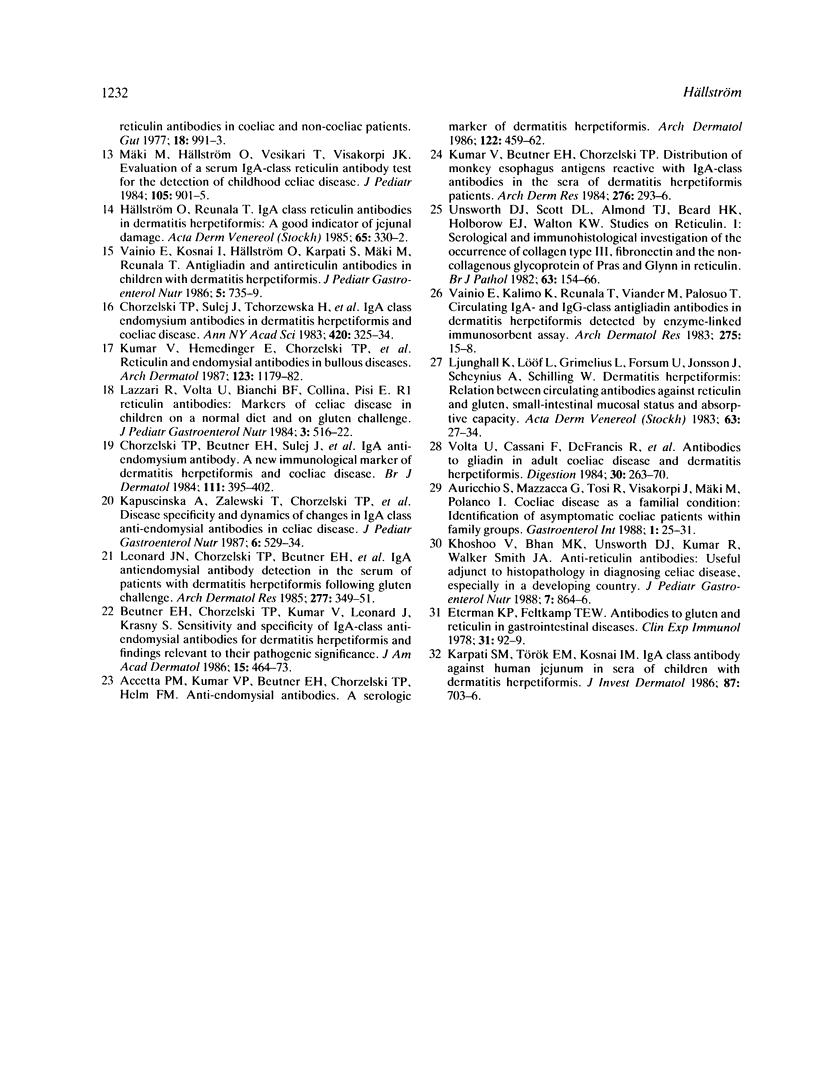
Images in this article
Selected References
These references are in PubMed. This may not be the complete list of references from this article.
- Accetta P., Kumar V., Beutner E. H., Chorzelski T. P., Helm F. Anti-endomysial antibodies. A serologic marker of dermatitis herpetiformis. Arch Dermatol. 1986 Apr;122(4):459–462. doi: 10.1001/archderm.122.4.459. [DOI] [PubMed] [Google Scholar]
- Alp M. H., Wright R. Autoantibodies to reticulin in patients with idiopathic steatorrhoea, coeliac disease, and Crohn's disease, and their relation to immunoglobulins and dietary antibodies. Lancet. 1971 Sep 25;2(7726):682–685. doi: 10.1016/s0140-6736(71)92249-5. [DOI] [PubMed] [Google Scholar]
- Beutner E. H., Chorzelski T. P., Kumar V., Leonard J., Krasny S. Sensitivity and specificity of IgA-class antiendomysial antibodies for dermatitis herpetiformis and findings relevant to their pathogenic significance. J Am Acad Dermatol. 1986 Sep;15(3):464–473. doi: 10.1016/s0190-9622(86)70195-3. [DOI] [PubMed] [Google Scholar]
- Chorzelski T. P., Beutner E. H., Sulej J., Tchorzewska H., Jablonska S., Kumar V., Kapuscinska A. IgA anti-endomysium antibody. A new immunological marker of dermatitis herpetiformis and coeliac disease. Br J Dermatol. 1984 Oct;111(4):395–402. doi: 10.1111/j.1365-2133.1984.tb06601.x. [DOI] [PubMed] [Google Scholar]
- Chorzelski T. P., Sulej J., Tchorzewska H., Jablonska S., Beutner E. H., Kumar V. IgA class endomysium antibodies in dermatitis herpetiformis and coeliac disease. Ann N Y Acad Sci. 1983;420:325–334. doi: 10.1111/j.1749-6632.1983.tb22220.x. [DOI] [PubMed] [Google Scholar]
- Dias J., Unsworth D. J., Walker-Smith J. A. Antigliadin and antireticulin antibodies in screening for coeliac disease. Lancet. 1987 Jul 18;2(8551):157–158. doi: 10.1016/s0140-6736(87)92356-7. [DOI] [PubMed] [Google Scholar]
- Eade O. E., Lloyd R. S., Lang C., Wright R. IgA and IgG reticulin antibodies in coeliac and non-coeliac patients. Gut. 1977 Dec;18(12):991–993. doi: 10.1136/gut.18.12.991. [DOI] [PMC free article] [PubMed] [Google Scholar]
- Eterman K. P., Feltkamp T. E. Antibodies to gluten and reticulin in gastrointestinal diseases. Clin Exp Immunol. 1978 Jan;31(1):92–99. [PMC free article] [PubMed] [Google Scholar]
- Kapuscinska A., Zalewski T., Chorzelski T. P., Sulej J., Beutner E. H., Kumar V., Rossi T. Disease specificity and dynamics of changes in IgA class anti-endomysial antibodies in celiac disease. J Pediatr Gastroenterol Nutr. 1987 Jul-Aug;6(4):529–534. doi: 10.1097/00005176-198707000-00006. [DOI] [PubMed] [Google Scholar]
- Khoshoo V., Bhan M. K., Unsworth D. J., Kumar R., Walker Smith J. A. Anti-reticulin antibodies: useful adjunct to histopathology in diagnosing celiac disease, especially in a developing country. J Pediatr Gastroenterol Nutr. 1988 Nov-Dec;7(6):864–866. [PubMed] [Google Scholar]
- Kumar V., Beutner E. H., Chorzelski T. P. Distribution of monkey esophagus antigens reactive with IgA-class antibodies in the sera of dermatitis herpetiformis patients. Arch Dermatol Res. 1984;276(5):293–296. doi: 10.1007/BF00404620. [DOI] [PubMed] [Google Scholar]
- Kumar V., Hemedinger E., Chorzelski T. P., Beutner E. H., Valeski J. E., Kowalewski C. Reticulin and endomysial antibodies in bullous diseases. Comparison of specificity and sensitivity. Arch Dermatol. 1987 Sep;123(9):1179–1182. [PubMed] [Google Scholar]
- Kárpáti S., Török E., Kósnai I. IgA class antibody against human jejunum in sera of children with dermatitis herpetiformis. J Invest Dermatol. 1986 Dec;87(6):703–706. doi: 10.1111/1523-1747.ep12456660. [DOI] [PubMed] [Google Scholar]
- Lazzari R., Volta U., Bianchi F. B., Collina A., Pisi E. R1 reticulin antibodies: markers of celiac disease in children on a normal diet and on gluten challenge. J Pediatr Gastroenterol Nutr. 1984 Sep;3(4):516–522. [PubMed] [Google Scholar]
- Leonard J. N., Chorzelski T. P., Beutner E. H., Sulej J., Griffiths C. E., Kumar V. J., Fry L. IgA anti-endomysial antibody detection in the serum of patients with dermatitis herpetiformis following gluten challenge. Arch Dermatol Res. 1985;277(5):349–351. doi: 10.1007/BF00509231. [DOI] [PubMed] [Google Scholar]
- Ljunghall K., Löf L., Grimelius L., Forsum U., Jonsson J., Scheynius A., Schilling W. Dermatitis herpetiformis: relation between circulating antibodies against reticulin and gluten, small-intestinal mucosal status and absorptive capacity. Acta Derm Venereol. 1983;63(1):27–34. [PubMed] [Google Scholar]
- Magalhaes A. F., Peters T. J., Doe W. F. Studies on the nature and significance of connective tissue antibodies in adult coeliac disease and Crohn's disease. Gut. 1974 Apr;15(4):284–288. doi: 10.1136/gut.15.4.284. [DOI] [PMC free article] [PubMed] [Google Scholar]
- Mallas E. G., Williamson N., Cooper B. T., Cooke W. T. IgA class reticulin antibodies in relatives of patients with coeliac disease. Gut. 1977 Aug;18(8):647–650. doi: 10.1136/gut.18.8.647. [DOI] [PMC free article] [PubMed] [Google Scholar]
- Mäki M., Hällström O., Vesikari T., Visakorpi J. K. Evaluation of a serum IgA-class reticulin antibody test for the detection of childhood celiac disease. J Pediatr. 1984 Dec;105(6):901–905. doi: 10.1016/s0022-3476(84)80074-8. [DOI] [PubMed] [Google Scholar]
- Rizzetto M., Doniach D. Types of 'reticulin' antibodies detected in human sera by immunofluorescence. J Clin Pathol. 1973 Nov;26(11):841–851. doi: 10.1136/jcp.26.11.841. [DOI] [PMC free article] [PubMed] [Google Scholar]
- Seah P. P., Fry L., Hoffbrand A. V., Holborow E. J. Tissue antibodies in dermatitis herpetiformis and adult coeliac disease. Lancet. 1971 Apr 24;1(7704):834–836. doi: 10.1016/s0140-6736(71)91499-1. [DOI] [PubMed] [Google Scholar]
- Seah P. P., Fry L., Holborow E. J., Rossiter M. A., Doe W. F., Magalhaes A. F., Hoffbrand A. V. Antireticulin antibody: incidence and diagnostic significance. Gut. 1973 Apr;14(4):311–315. doi: 10.1136/gut.14.4.311. [DOI] [PMC free article] [PubMed] [Google Scholar]
- Seah P. P., Fry L., Rossiter M. A., Hoffbrand A. V., Holborow E. J. Anti-reticulin antibodies in childhood coeliac disease. Lancet. 1971 Sep 25;2(7726):681–682. doi: 10.1016/s0140-6736(71)92248-3. [DOI] [PubMed] [Google Scholar]
- Stevens F. M., Lloyd R., Egan-Mitchell B., Mylotte M. J., Fottrell P. F., Wright R., McNicholl B., McCarthy C. F. Reticulin antibodies in patients with coeliac disease and their relatives. Gut. 1975 Aug;16(8):598–602. doi: 10.1136/gut.16.8.598. [DOI] [PMC free article] [PubMed] [Google Scholar]
- Unsworth D. J., Scott D. L., Almond T. J., Beard H. K., Holborow E. J., Walton K. W. Studies on reticulin. I: Serological and immunohistological investigations of the occurrence of collagen type III, fibronectin and the non-collagenous glycoprotein of Pras and Glynn in reticulin. Br J Exp Pathol. 1982 Apr;63(2):154–166. [PMC free article] [PubMed] [Google Scholar]
- Vainio E., Kosnai I., Hällström O., Karpati S., Mäki M., Reunala T. Antigliadin and antireticulin antibodies in children with dermatitis herpetiformis. J Pediatr Gastroenterol Nutr. 1986 Sep-Oct;5(5):735–739. doi: 10.1097/00005176-198609000-00012. [DOI] [PubMed] [Google Scholar]
- Volta U., Bonazzi C., Pisi E., Salardi S., Cacciari E. Antigliadin and antireticulin antibodies in coeliac disease and at onset of diabetes in children. Lancet. 1987 Oct 31;2(8566):1034–1035. doi: 10.1016/s0140-6736(87)92608-0. [DOI] [PubMed] [Google Scholar]
- Volta U., Cassani F., De Franchis R., Lenzi M., Primignani M., Agape D., Vecchi M., Bianchi F. B., Pisi E. Antibodies to gliadin in adult coeliac disease and dermatitis herpetiformis. Digestion. 1984;30(4):263–270. doi: 10.1159/000199118. [DOI] [PubMed] [Google Scholar]
- Williamson N., Asquith P., Stokes L., Jowett W., Cooke W. T. Anticonnective tissue and other antitissue 'antibodies' in the sera of patients with coeliac disease compared with the findings in a mixed hospital population. J Clin Pathol. 1976 Jun;29(6):484–494. doi: 10.1136/jcp.29.6.484. [DOI] [PMC free article] [PubMed] [Google Scholar]



